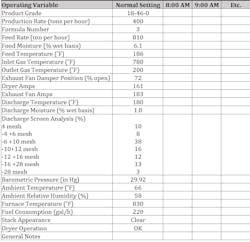Recordkeeping for effective dryer maintenance
The increasing sophistication and cost of dryers used for bulk solids handling operations make dryer maintenance very complex, which can affect an operation’s profits. Much of a maintenance program’s effectiveness stems from keeping an accurate maintenance record and using that record for planning.
Maintenance planning entails recording a dryer’s performance and normal operating conditions and scheduling dryer inspections and regular preventive maintenance. As long as a maintenance record is organized, complete and up to date, its physical form is not critical. Hard copies of information can be organized in a filing system or bound into record or logbooks, or the information can be consolidated and transferred to a computer database. A maintenance record should include the following information:
- Legal documentation
- Operations and maintenance manuals
- Drawings
- Parts lists
- Daily maintenance procedures
- Special and emergency maintenance procedures
- Safety procedures
- Baseline operation record
- Operations log
- Maintenance log
- Lubrication record
- Annual turnaround procedure
Legal documentation
Legal documentation includes copies of all legal documents related to a dryer and its operation, including such items as licenses; permits; applications to the Corps of Engineers, Environmental Protection Agency (EPA) and Occupational Safety and Health Administration (OSHA); inspection reports; test reports; and the American Society of Mechanical Engineers boiler and pressure vessel code certifications, including original, repair and modification records of design, materials and welding procedures and tests.
Keeping this material organized can help ensure that the entire plant complies with pertinent regulations. Maintaining such material demonstrates that a genuine effort has been made to comply with these regulations, which can help with any legal and regulatory issues in the future.
Operations and maintenance manuals
Manuals for the dryer and related equipment can help train and provide further reference for supervisors, operators and maintenance workers. To help workers quickly and easily access the information they need, systematically update the manuals with supplementary information, manufacturer correspondence, operation and maintenance notes and copies of related technical articles and data.
If a dryer’s installation differed from the design specifications, insert corrected “as-built” drawings and specifications into the manuals. This information can simplify dryer startup, training and maintenance and is essential for managing process upsets and mechanical emergencies.
Drawings
Save copies of all arrangement and installation drawings of the dryer and related equipment. Catalog them to simplify identifying and locating a particular drawing. To save storage space and preserve the drawings, keep them in stick files, in which up to 50 drawings can be clamped onto metal bars and stored in a hanging file. Reduced copies of the drawings can be bound for quick access or converted to microfilm. If drawings are not already in digital format, they can be scanned and stored for safekeeping. No matter which cataloging system is used, establish controls to prevent loss or unauthorized removal of any drawings.
The drawings can help workers understand certain dryer components, such as the drive assembly, and thus facilitate dryer inspections and repairs. The drawings can also help establish or confirm repair parts information. Although a dryer manufacturer may not release proprietary detail drawings, which specify individual parts, the detail drawings may be referenced on the arrangement and installation drawings, so the manufacturer can be asked for the information if necessary.
Parts lists
Parts lists for the dryer and related equipment include details such as material specifications, sizes and grades of bolts and other fasteners, tolerances, hardnesses, finishes and lubricants. If these details aren’t included on the lists, be sure to add them.
Also add information about which parts should be ordered from the supplier so the parts meet all original specifications and incorporate all design, material and manufacturing improvements. For instance, if the manufacturer of a rotary dryer states that the dryer’s thrust roll assembly has been redesigned, increasing the part’s design capacity by 40% but increasing its cost by only 15%, add the information to the parts list. Also note which parts have long delivery times and which standard parts require special modifications, such as machining to provide added clearance when assembled or additional capabilities for sensing temperature, pressure, vibration and flow. Maintaining such parts information can help avoid unpleasant surprises during emergencies and ensure that the correct parts are ordered.
Daily maintenance procedures
Daily maintenance procedures include instructions for the shift supervisor’s simple walk-through inspection, performed once during each shift, and the maintenance worker’s more thorough daily inspection. These procedures can be used for training supervisors and maintenance workers, as well as for periodically training new workers.
Special and emergency maintenance procedures
Special and emergency maintenance procedures specify the steps required in an emergency condition, which may require a scheduled or unscheduled shutdown. The steps can include stopping feed to the dryer, partially or completely emptying the dryer, and cooling it down. For instance, if a dryer is severely overheating and vibrating, and likely to fail, repairing it during operation would be unsafe. Instead, it is best to immediately reduce the plant’s production rate if possible or stop production upstream from the dryer. The latter permits the dryer to be partially or completely emptied and cooled prior to its shutdown. Keeping a record of special and emergency maintenance procedures can help companies plan for emergencies and train workers in advance, ensuring a much safer and more orderly procedure if an emergency occurs.
Safety procedures
Safe practices for workers who operate and maintain the dryer are always a top priority throughout planning, training and operation. For instance, safety procedures typically list information about proper lighting for all workers near the dryer and specific information for maintenance workers, such as using the buddy system, using proper tools and ventilation, using equipment lockouts to ensure that the dryer’s power supply is cut off during maintenance, scheduling frequent supervisor checks and blocking or locking out the dryer to prevent unexpected shifting or rotation of a rotary dryer’s shell when maintenance workers enter it. Post-repair safety procedures that are typically listed include replacing equipment guards, discarding any debris and removing any hoses, cables or tools used.
Baseline operation record
The baseline operation record lists a dryer’s normal operating conditions. The conditions should be recorded at dryer startup and then updated at regular intervals. The record lists normal operating speeds, temperatures, flows, feed rates, amperage readings, vibration readings (frequency graphs of the vibration levels) and other data. Any changes in how the dryer is operated can also be listed, such as increasing the feed rate, along with the date a change is instituted. The record can serve as a statistical quality control for future reference, in that the information about the dryer’s normal operating conditions can help workers quickly evaluate problems and choose solutions when the dryer operates abnormally. For instance, checking the dryer’s normal vibration readings after spotting wear on a dryer part can help workers determine when the wear started and how serious the vibration is.
Operations log
The operations log, as shown in Table 1, records the dryer’s operating variables, such as inlet and outlet material and gas temperatures, dryer drive motor and exhaust fan amperage readings, and production rate on an hourly basis. The log can show deviations from standard norms, excursions above posted safe limits and operating behaviors that vary from the baseline operation record (represented in Table 1 as the Normal Setting column). A worker responsible for both operations and maintenance should regularly review the log to look for such abnormalities so they can be investigated and corrected. A good log can also help the worker spot the problems that most frequently cause downtime so those problems can be resolved first.
Table 1: Sample page from a dryer operations log
Maintenance log
The maintenance log tracks all dryer adjustments, repairs and inspection data. Recording internal clearances of a rotary dryer’s roller bearing assemblies during regular inspections is a useful preventive maintenance tool that enables workers to check bearing wear. The regular recording of vibration readings, which should be stored in the maintenance log, for bearing housings and drive components when the equipment is well adjusted and in good condition provides a good baseline for measuring vibration severity later. For instance, a new vibration reading that shows higher vibration amplitude than an older reading may indicate the first symptom of a problem, such as a lack of lubrication, that if left unchecked could suddenly require repair and cause unscheduled downtime. Regularly recording temperatures at specific locations throughout the dryer by using an optical or infrared pyrometer can help workers locate abnormal hot spots later. A hot spot can indicate tooth wear from abnormally heavy contact areas on large gear teeth, which is easily corrected by adjusting the gears or adding lubrication.
Reviewing the log to see what type of maintenance an older dryer has required can be the first step in determining whether the dryer should be repaired, rebuilt or replaced.
Lubrication record
The lubrication record includes the supplier’s procedures for lubricating the dryer. It specifies the correct oil or grease types and grades, where they should be used and at what intervals, as well as the procedure checklists and a log for recording completed lubrication. Lubrication is typically performed by a maintenance worker as part of the daily inspection. If the worker notices and reports any smoke or heavy oil or grease leakage during lubrication, which may indicate that a seal or other component has failed, the failure can be promptly investigated. Recording the smoke or leakage in the lubrication log can also provide helpful information for investigating subsequent component failures.
Annual turnaround procedure
The annual turnaround procedure lists the steps for performing major dryer repairs or rebuilding a dryer during the off-season or other scheduled downtime. The procedure can help workers plan and coordinate the required work, so it is successfully completed in the allotted time. Coordination with production schedules in a large plant is especially important because the turnaround procedure often involves diverting dryer feed to storage tanks or other production lines in the plant. Coordination with outside staff, such as manufacturer-supplied technicians and outside contractors, ensures that their work is completed as quickly as possible to minimize production losses.
The annual turnaround procedure can minimize production losses and reduce related costs by helping companies not only plan the turnaround, but also by training the workers who will be involved to make early decisions that incorporate any improvements into parts that are being replaced. Record any repairs made at the annual turnaround in the maintenance log.
Conclusion
Establishing and maintaining a complete maintenance record that includes the elements described in this article can make any dryer maintenance program more effective. The maintenance record can help workers quickly spot abnormal dryer operation, identify the problem’s cause and correct it. Referring to the maintenance record can also help determine whether an older dryer should be repaired, rebuilt or replaced.
Heyl Patterson Thermal Processing





